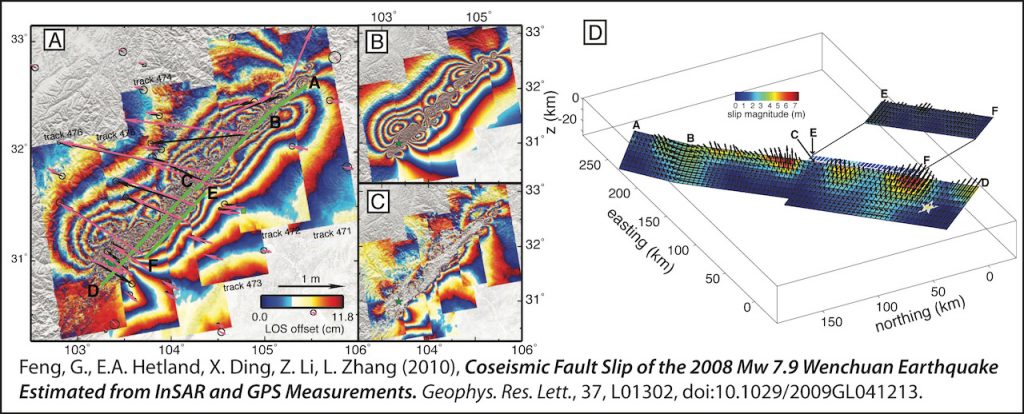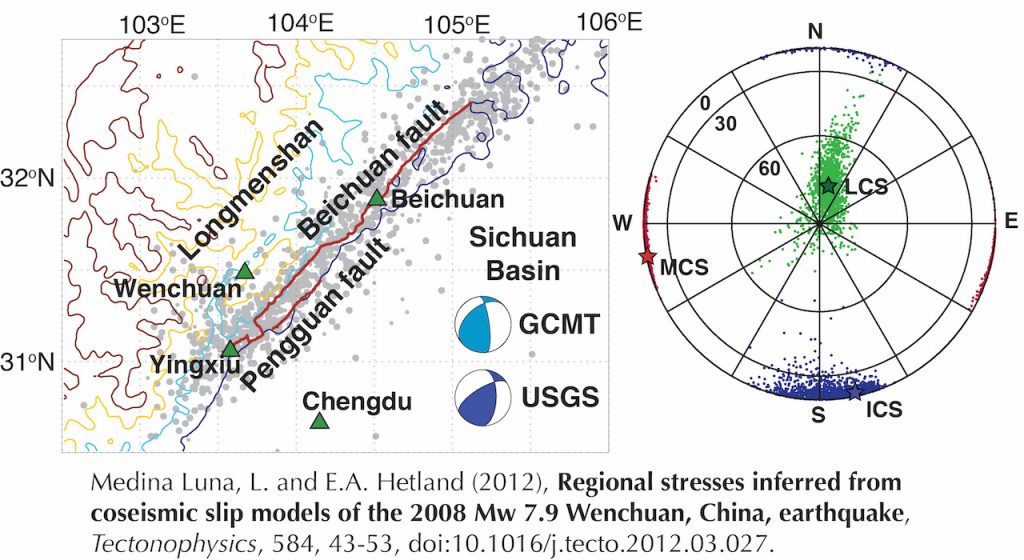2008 Wenchuan earthquake
The 2008 Wenchuan earthquake ruptured over 200 km of the Beichuan fault, which is at the transition from the Sichuan basin to the Longmen Shan, and the Tibet plateau further to the east. Additionally, about 70 km of a parallel fault, the Pengguan fault, also ruptured. Multiple lines of evidence indicated that this earthquake involved both reverse thrust slip and right-lateral strike slip, and the emerging view is that the thrust and strike slip were partitioned on separate fault segments with different dip.

Based geodetic data, we estimated a model of how the faults slipped at depth during the earthquake. We approximated the faults with five segments with varying dip (the fault model was based largely on ancillary data). We found that the sense of slip (either reverse or strike slip) was largely correlated with the dip of the fault, a conclusion that several other authors have come to, with predominantly reverse slip on shallow dipping faults in the southwest, and strike slip on steeply dipping faults in the northeast.
Feng, G., E.A. Hetland, X. Ding, Z. Li, L. Zhang (2010), Coseismic Fault Slip of the 2008 Mw 7.9 Wenchuan Earthquake Estimated from InSAR and GPS Measurements. Geophys. Res. Lett., 37, L01302, doi:10.1029/2009GL041213. (fault model)
The correlation of fault orientation and sense of slip in the Wenchuan earthquake suggests two possibilities: (1) that the stresses that led to the earthquake are oriented differently in the southwest and northeast, or (2) that the stress is homogeneous in the region but the dip of the fault structures cause a partitioning of the slip. It is most commonly accepted that a fault that is stressed to the point of failure will slip in the direction of the maximum shear stress on the fault plane. Additionally, for a given state of stress, the shear stresses on two fault planes with different orientations can be drastically different. Assuming that the sense of slip on the fault indicated the direction of the maximum accumulated shear stress prior to the earthquake, we tested whether the slip models were consistent with a homogeneous state of stress.

We used several published coseismic slip models, and found that all of the considered model were consistent with a fairly narrow range of directions of the principal stresses. In other words, as the sense of slip on all of the fault planes (both shallowly and steeply dipping) can be explained by the same stress tensor, the Wenchuan earthquake does not indicate that the stresses are heterogeneous in the rupture area. While we could constrain the stress directions, we were not able to constrain the magnitudes of the background stresses responsible for the Wenchuan earthquake. We are currently investigating models of earthquake frictional failure, as well as aftershocks, in order to try to constrain both the magnitudes of stress, as well as investigate the propagation of failure on a complex fault system.